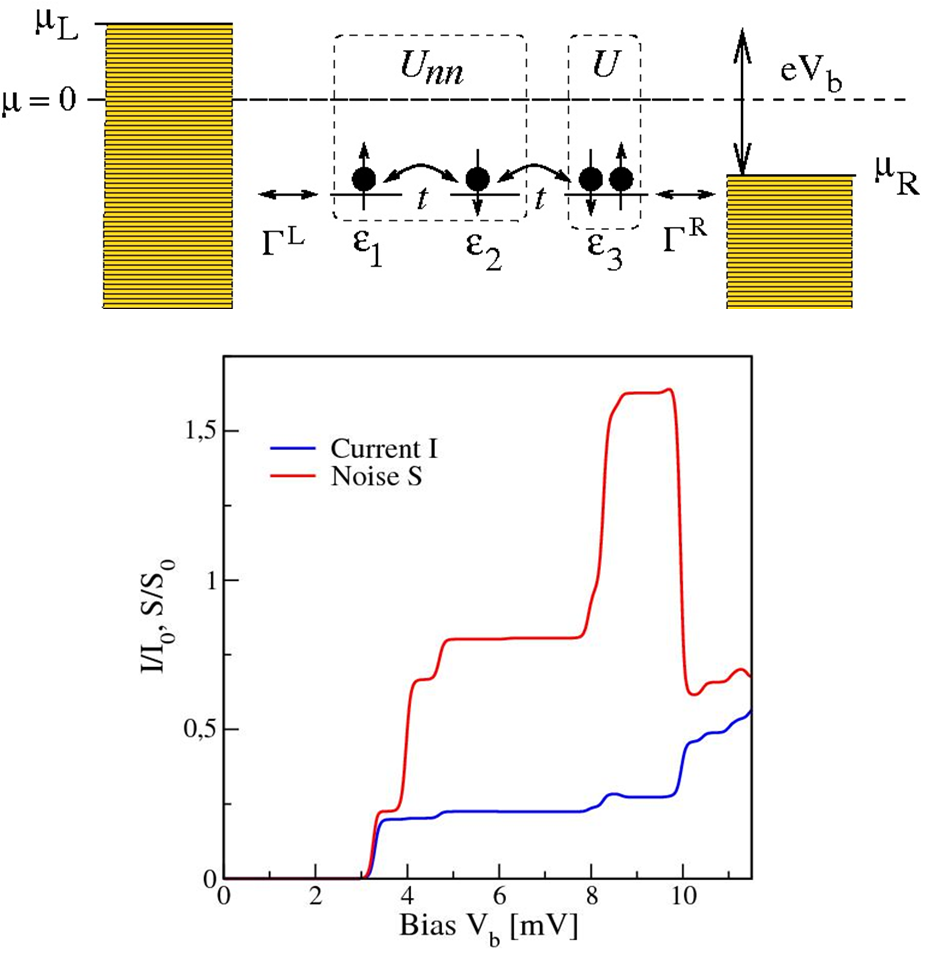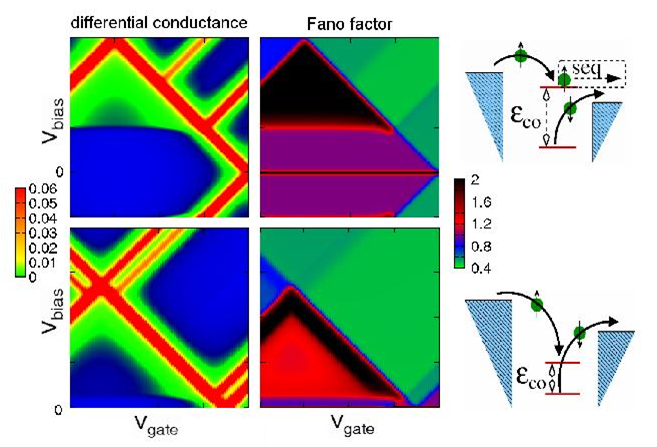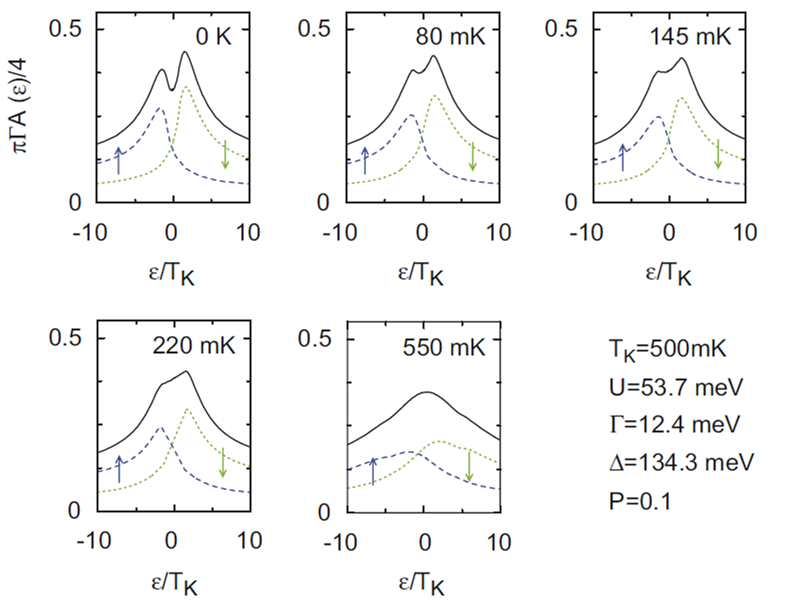B2.2: Single-Electron Devices and Spintronics
Subproject Leader:
Gerd Schön
Institut für Theorie der Kondensierten Materie (TKM), KIT
Alexander Shnirman
Institut der Theoretischen Festkörperphysik (TFP), KIT
Contributing Scientists:
Jasmin Aghassi, Dmitri Golubev, Matthias Hettler, Juha Leppäkangas, Michael Marthaler, Jan Martinek (guest scientist), Pablo San Jose, Axel Thielmann, Yasuhiro Utsumi
Introduction
In nano-scale devices the energy change associated with the transfer of a single electron charge frequently is significant. Examples are (i) metal islands and tunnel junctions fabricated by lithographic techniques, (ii) quantum dots, created, e.g., by lateral structuring in 2-dimensional electron gases, as well as (iii) molecules, clusters or self-organized grown quantum dots which are coupled to electrodes. In these systems ‘Coulomb blockade’ effects arise, which make it possible to control and observe the tunneling of single electrons. A rich variety of ‘single-electron’ effects have been observed and studied, both theoretically and experimentally, and, in fact, several applications have been demonstrated by now. The field has remained remarkably active for many years and appears to remain so for some time to come with novel questions arising, e.g., in the context of spin-dependent tunneling, quantum state engineering, and quantum metrology.
We have developed a systematic description for single-electron devices, which allows us to treat coherent and non-equilibrium processes in higher order, and applied it to a number of problems, including:
-
Shot noise in tunneling through single and multiple quantum dots and molecules, incl. correlation effects.
-
Spin-dependent tunneling through single-electron tunneling devices.
-
Non-equilibrium transport through quantum dots with strong coupling to the electrodes. This system displays properties known from Kondo or quantum impurity systems.
-
Generation and detection of entangled electron states in multi-dot systems, competition of interaction and interference effect, e.g., in Aharonov-Bohm interferometers.
-
Full counting statistics of single-electron tunneling and tests of the fluctuation theorem.
-
Charge pumping in Josephson junction arrays.
1. Shot Noise in Transport through Quantum Dots and Multi-Dot Systems
We have studied charge transport through nanoscopic objects, e.g., quantum dots or molecules or chains of quantum dots that are weakly coupled to metallic electrodes. The current-voltage characteristics as well as the current noise were calculated within leading and next-to-leading order perturbation expansion in the coupling strengths. Depending on the level positions and the coupling strength to the leads we find regions of negative differential conductance accompanied with super-Poissonian noise, i.e., above the level of uncorrelated tunneling events [1].
In multilevel quantum dots coupled to leads we observed that cotunneling-assisted sequential tunneling (CAST) processes play a dominant role in the transition region from Coulomb blockade to sequential tunneling (see Fig. 2). We analyzed for intermediate coupling strength the dependence of the conductance due to CAST processes on the temperature, coupling constant, and gate voltage [2]. While the onset of inelastic cotunneling is associated with a super-Poissonian noise, the noise is even stronger above the threshold for CAST processes.
2. Spin-Dependent Tunneling in Single-Electron Devices
Both, the investigation of spin dependent electron transport and the study of strong Coulomb interaction effects in transport through nanostructures are by now well-established research areas. The combination of the two different paradigms within one system, however, is still an active research field. A suitable model system for a basic study of the interplay of the two effects is provided by a quantum dot attached to ferromagnetic leads. In earlier work we had studied the Kondo effect in single-electron tunneling through quantum dots, in particular how the Kondo effect is modified by the presence of ferromagnetic leads. The real-time diagrammatic technique developed in our group provides a systematic description of the nonequilibrium dynamics of a system with strong local electron correlations. We evaluated the theory in a charge- and spin-conserving approximation that accounts not only for Kondo correlations but also for the spin splitting and spin accumulation out of equilibrium. We showed that the Kondo resonances, split by the applied bias voltage, may be spin polarized. The effects are observable in the nonlinear differential conductance [3]
3. Single-Electron Tunneling and the Fluctuation Theorem
According to the second law of thermodynamics, the entropy of a macroscopic system driven out of equilibrium increases with time until equilibrium is reached. In contrast, for a mesoscopic system measured during a sufficiently short time, the entropy may either increase or decrease. The “fluctuation theorem” (FT), which relies only on the micro-reversibility of the underlying equation of motion, states that the probability distribution P(ΔS) for processes increasing or decreasing the entropy by ΔS during a short time interval obeys the relation P(ΔS)/P(-ΔS)=exp(ΔS). This simple and universal relation has been proven for thermally equilibrated systems, Markovian stochastic processes, quantum systems, and mesoscopic conductors. Only recently experiments were performed with mesoscopic quantum systems. In these experiments the statistics of single-electron tunneling in a double quantum dot system in a GaAs/GaAlAs heterostructure was probed by an asymmetrically coupled quantum point contact (QPC), which allows resolving the direction of the tunneling process. We analyzed these experiments in the frame of the FT [4]. The experimental data appeared to violate the FT. After analyzing various potential sources for the discrepancy we concluded that the nonequilibrium shot noise of the QPC electrometer, which is used to study the transport, induces strong dot-level fluctuations which significantly influence the tunneling statistics. Taking these modifications into account we find consistency with the FT.
4. Quantum Pumps
We have studied charge pumping in Josephson junction systems, i.e., adiabatic transport of charge in the absence of an external bias, induced by a cyclic modulation of the electrostatic potential. In phase-biased Josephson junction arrays in the regime in which the charging enegry EC is much higher than the Josephson energy EJ, charge pumping leads to adiabatic transport of single Cooper pairs. There are two reasons to study Cooper pair pumps (CPP): first, the control on the pumped charge in these systems reaches an accuracy that makes them potential candidates for a new metrological current standard. Second, it has been experimentally proven that the charge pumped over a cycle in a CPP is a geometric quantity, which can be directly related to the Berry’s phase accumulated by the wave-function of the system [5].
[1]
1. J. Aghassi, A. Thielmann, M.H. Hettler, and G. Schön, Shot noise in transport through two coherent strongly coupled quantum dots, Phys. Rev. B 73, 195323 (2006)
[2]
2. J. Aghassi, M.H. Hettler, and G. Schön, Co-tunneling assisted sequential tunneling in multi-level quantum dots, Appl. Phys. Lett. 92, 202101 (2008)
[3]
3. J. Martinek, L. Borda, Y. Utsumi, J. König, J. von Delft, D.C. Ralph, G. Schön, and S. Maekawa, Kondo effect in single-molecule spintronics devices, J. Magn. Magn. Mater. 310, e343 (2007)
[4]
4. Y. Utsumi, D.S. Golubev, M. Marthaler, K. Saito, T. Fujisawa, and G. Schön, Bidirectional single-electron counting and the fluctuation theorem, Phys. Rev. B 81, 125331 (2010)
[5]
5. V. Brosco, M. Jerger, P. San-Jose, G. Zarand, A. Shnirman, and G. Schön, Resonant all-electric spin pumping with spin-orbit coupling, Phys. Rev. B 82, 041309(R) (2010)
List of Publications 2006-2011 as PDF
Subproject Report 2006-2010 as PDF


